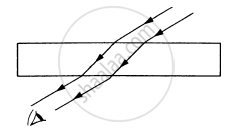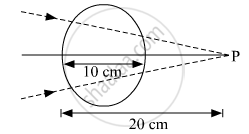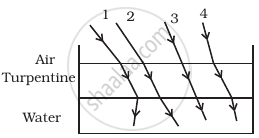Advertisements
Advertisements
Question
A laser light is focussed by a converging lens. Will there be a significant chromatic aberration?
Solution
No, there will not be a significant chromatic aberration because a laser light is monochromatic in nature. Therefore, all light will get converged at the same point.
APPEARS IN
RELATED QUESTIONS
Does the apparent depth of a tank of water change if viewed obliquely? If so, does the apparent depth increase or decrease?
The refractive index of diamond is much greater than that of ordinary glass. Is this fact of some use to a diamond cutter?
Light incident normally on a plane mirror attached to a galvanometer coil retraces backward as shown in Figure. A current in the coil produces a deflection of 3.5° of the mirror. What is the displacement of the reflected spot of light on a screen placed 1.5 m away?

A narrow beam of light passes through a slab obliquely and is then received by an eye following figure. The index of refraction of the material in the slab fluctuates slowly with time. How will it appear to the eye? The twinkling of stars has a similar explanation.

A vessel contains water up to a height of 20 cm and above it an oil up to another 20 cm. The refractive indices of the water and the oil are 1.33 and 1.30 respectively. Find the apparent depth of the vessel when viewed from above.
A converging beam of light traveling in air converges at a point P as shown in the figure. When a glass sphere of refractive index 1⋅5 is introduced in between the path of the beam, calculate the new position of, the image. Also, draw the ray diagram for the image formed.

Stars twinkle due to ______.
A ray of light travelling in a transparent medium of refractive index n falls, on a surface separating the medium from air at an angle of incidents of 45°. The ray can undergo total internal reflection for the following n.
What is angle of deviation due to refraction?
Obtain the equation for apparent depth.
Why do stars twinkle?
Obtain the equation for critical angle.
A ray of light passes through equilateral prism such that the angle of incidence is equal to angle of emergence and each of these angles is equal to `(3/4)^"th"` the angle of prism. The angle of deviation is ______.
When a ray of light is incident normally on one refracting surface of an equilateral prism of refractive index 1.5, the emerging ray ______.
`[sin^-1(1/1.5)=41.8^circ]`
When a ray of light is refracted from one medium to another, then the wavelength changes from 6000Å to 4000Å. The critical angle for the interface will be ______.
A concave mirror of focal length 'f1' is placed at a distance 'd' from a convex lens of focal length 'f2'. A parallel beam of light coming from infinity parallel to principal axis falls on the convex lens and then after refraction falls on the concave mirror. If it is to retrace the path, the distance 'd' should be ______.
If `"^imu_j` represents refractive index, when a light ray goes from medium i to medium j, then the product `"^2mu_1 xx ^3mu_2 xx ^4mu_3` is equal to ______.
The optical density of turpentine is higher than that of water while its mass density is lower. Figure shows a layer of turpentine floating over water in a container. For which one of the four rays incident on turpentine in figure, the path shown is correct?
Using Huygen's wave theory, show that (for refraction of light):
`sin i/sin r = "constant"`
where terms have their usual meaning. You must draw a neat and labelled diagram.
